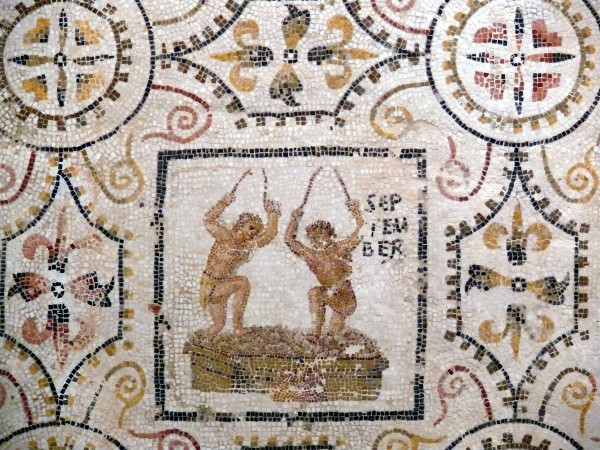 When the ancient Roman year began in March, at the time of the Vernal Equinox, September was the 7th month. Septum is Latin for 7. A lot has changed over the years.
When the ancient Roman year began in March, at the time of the Vernal Equinox, September was the 7th month. Septum is Latin for 7. A lot has changed over the years.
In 1582, the calendar experts of Pope Gregory XIII (Boncompagni) discovered a major flaw in Julius Caesar’s Julian calendar.
Every 128 years, the ancient calendar pushed back the historical date of Easter by one day. Enter the Gregorian calendar, the measure of months most of the world still uses today.
There is one problem with the Gregorian Calendar. In 3236 years, just like the Julian Calendar, it’ll drop a day. By then, most likely, no-one will care.
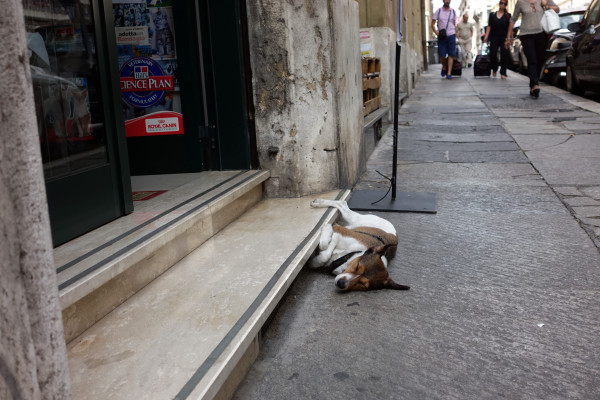 September in Rome is a transitional month, moving summer into autumn. The Sirius star that brought the ‘Dog Days’ of summer has moved on but in early September, the 90° (Fahrenheit) afternoons are still here. City dogs are still looking for a place to nod out.
September in Rome is a transitional month, moving summer into autumn. The Sirius star that brought the ‘Dog Days’ of summer has moved on but in early September, the 90° (Fahrenheit) afternoons are still here. City dogs are still looking for a place to nod out.
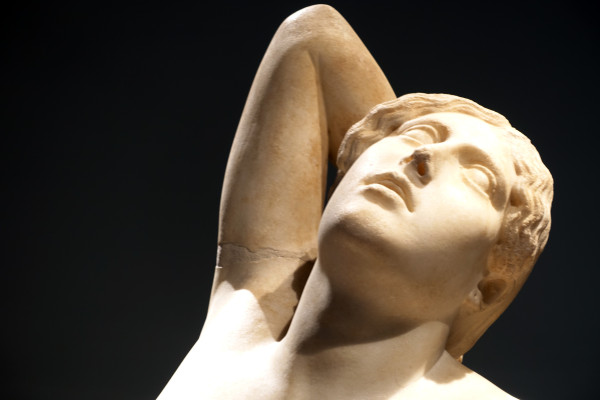 Summer clothes are reduced to sale prices. SPF crèmes are on sale at the pharmacies and Romans are getting in their last few weeks of beneficial rays of the sun at the Fregene Beach in Ostia, the official Lido of Rome.
Summer clothes are reduced to sale prices. SPF crèmes are on sale at the pharmacies and Romans are getting in their last few weeks of beneficial rays of the sun at the Fregene Beach in Ostia, the official Lido of Rome.
Summers in Rome are hot but in the late afternoons the summer breeze known as the ‘Ponentino’ comes off the river and cools down the Piazze. Dining ‘al fresco’ is a 2500 year tradition in this ancient city.
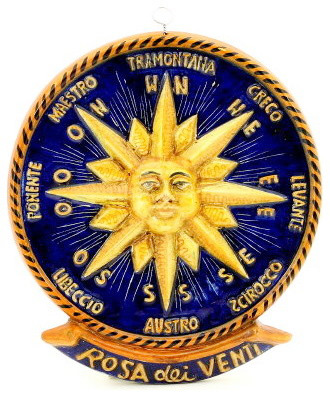 However, by September the winds will change. Beautiful sunny days can suddenly cloud over and kick up blistery gusts, rattling awnings, tossing up dust and tearing leaves from trees.
However, by September the winds will change. Beautiful sunny days can suddenly cloud over and kick up blistery gusts, rattling awnings, tossing up dust and tearing leaves from trees.
Romans have many names for the wind. They are much more personal when it comes to weather patterns. There are the cool ‘Grecale’ winds that come in from down from Croatia across the Adriatic, the mild ‘Ponente’ winds from Spain and Sardinia, the gusty ‘Libeccio’ winds from Corsica, the cold blistery ‘Tramontana’ winds from Austria and the hot, dusty ‘Sirocco’ winds that come up from Africa. You can tell the type of wind by the direction and temperature.
Often with the wind comes the rain. It appears suddenly, out of nowhere. Even the weather websites never see them coming. You can look at a perfect day with 0% chance of rain on your computer screen and yet there’ll be a thunderstorm out of your window.
Water has never been a problem in Rome, with the exception of plumbing leaks. Eleven ancient aqueducts brought in over 200 gallons of water per person per day until they were destroyed in 537 by Vitiges and the Ostrogoths.
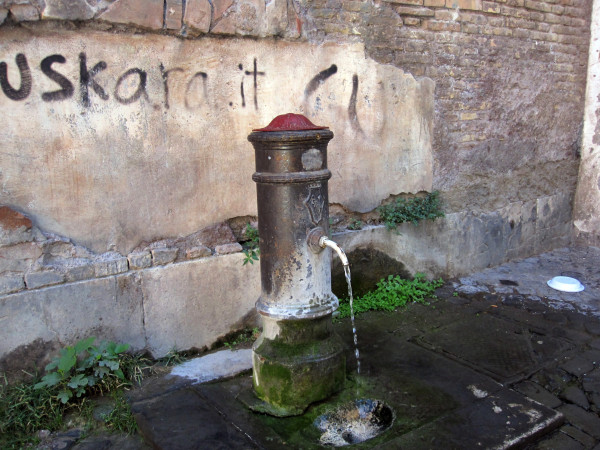 The volume of water might be less these days but there is still more than enough. So much, in fact, the water fountains just flow endlessly into the streets day and night.
The volume of water might be less these days but there is still more than enough. So much, in fact, the water fountains just flow endlessly into the streets day and night.
A couple of the ancient aqueducts are still serving Rome, the Aqua Vergine and Aqua Felice are still flowing. The Peschiere-Capore Aqueduct coming from the Apennine Mountains, about 100 miles northeast of Rome, has been bringing most of the water into the city since 1935.
Aside from the many famous Baroque fountains across the city, there are close to 2500 working drinking fountains affectionately known as ‘nasone’ or large noses because of their bent nose profile. The water is fresh, clean, cold and delicious.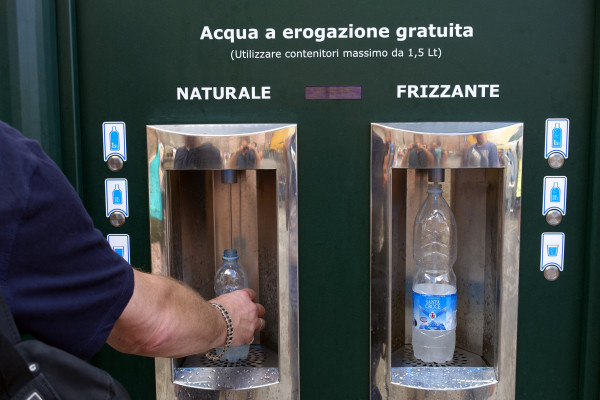
Close to the Coliseum, the city has installed a water dispenser with cold natural water and cold frizzante (sparkling) water. This is an amazing addition to the nasone fountains.
September is the month when the street vendors switch from selfie sticks (the new must have tourist equipment) to umbrellas, hats or shawls.
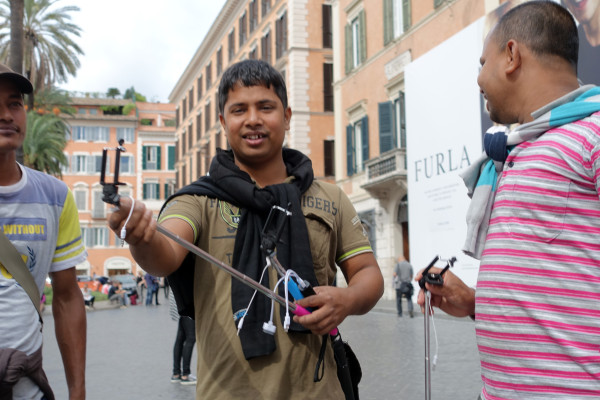 The selfie sticks are also the most annoying things to hit these heavily traveled stones in ages. It seems like most tourists these days care more about seeing themselves than seeing the places they’re visiting. After too many people were whacked by the telescoping smartphone enablers, most monuments and museums in Europe have forbidden, censored and banished them from the premises. However, that hasn’t stopped the street vendors calling “selfie, selfie, selfie” as if they were chanting an ancient incantation.
The selfie sticks are also the most annoying things to hit these heavily traveled stones in ages. It seems like most tourists these days care more about seeing themselves than seeing the places they’re visiting. After too many people were whacked by the telescoping smartphone enablers, most monuments and museums in Europe have forbidden, censored and banished them from the premises. However, that hasn’t stopped the street vendors calling “selfie, selfie, selfie” as if they were chanting an ancient incantation.
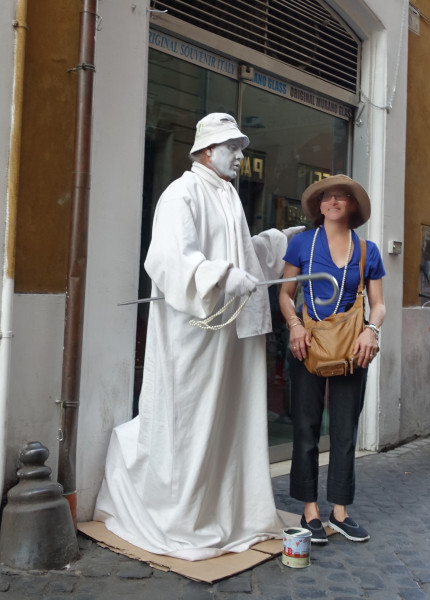 The street Buskers who were so ubiquitous in the past decade are gone from the via dei Fori Imperiali, although they are popping up in other tourist locations less surveilled by police.
The street Buskers who were so ubiquitous in the past decade are gone from the via dei Fori Imperiali, although they are popping up in other tourist locations less surveilled by police.
New Roman laws have deemed them a public nuisance. Although the costumes have gotten better in the past couple of years, Rome hasn’t attracted the best of Europe’s street performers. While cities like Barcelona thrive with talented street artists, Rome was plagued with the tired lycra pharaonic sarcophagus who’s been around since the 1980s, the black painted cowboys, the middle eastern levitating mystics or the creepy guy painted white who likes to touch people as they passed by.
In Dec 2013, an Italian tourist happened to snap a photo of one of the levitating mystics and didn’t leave a tip. The mystics accomplice, the guy who gets him into the balancing harness, chased down the tourist until the police were brought in. It’s been a downhill saga for the street statues ever since.
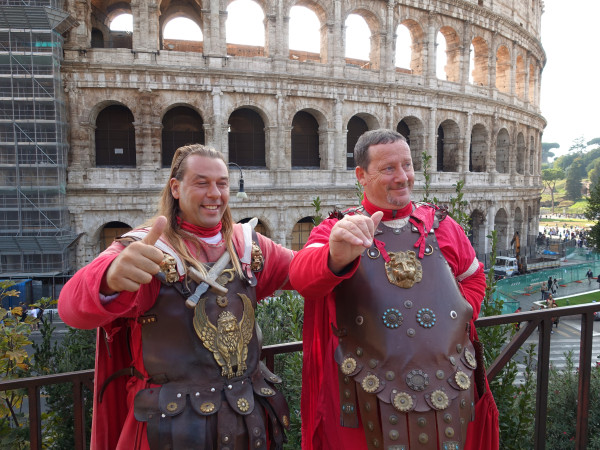 The big costume in Rome is the Centurion soldier, although the costumed actors prefer the term ‘Gladiatori’. Although the ‘non Roman’ buskers have been removed from the tourist areas, the Gladiatori have been left alone, as long as they don’t harass the tourists, con them into paying exorbitant prices for selfies or position themselves in the Piazza del Colosseo.
The big costume in Rome is the Centurion soldier, although the costumed actors prefer the term ‘Gladiatori’. Although the ‘non Roman’ buskers have been removed from the tourist areas, the Gladiatori have been left alone, as long as they don’t harass the tourists, con them into paying exorbitant prices for selfies or position themselves in the Piazza del Colosseo.
I never understood why the human statues never dressed as Roman Emperors. Is that too obvious? Or what about Biblical Saints? I think tourist would much rather have a photo taken with Julius Caesar or Jesus Christ than the creepy guy painted white. When in Rome, dress like Rome.
Along with the ban of annoying street mimes, Rome has put into effect a ban on drinking in the streets from midnight till 7am.
Bars must stop serving alcohol at 2:00am. The ban is in effect till October 31st, at least until most of the tourists are gone. Fines are for vendors selling alcohol to people drinking in the street and for the consumers.
Alcohol and bad behavior has become an increased problem all over Italy. In the past two years, three foreign students (two Americans and one German) died when they fell off the embankments of the Lungotevere, the road that runs along the river. Another American student was killed by a train when he wandered into the railway tunnel near St Peter’s Basilica. All the deaths involved heavy amounts of alcohol.
Rome’s music busker scene is getting better. For years, Rome’s street music was a sad complement of Italiana kitsch, mostly performed on the most maligned of all musical instruments, the accordion, the William Shatner of live music.
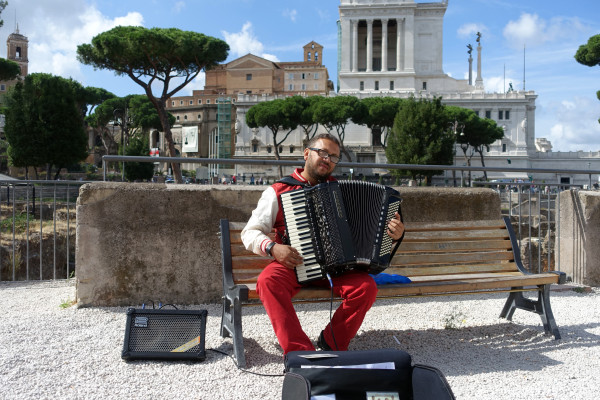
They would annoy tourists and residents at every opportunity, at museums, in front of monuments, by churches, in Piazze. Forget about having a nice quiet dinner in a beautiful small Piazza. It would always be ruined by the bad accordionist.
However, Rome has recently attracted a better genus of musician, including a brilliant Gypsy accordionist named Albert Michai who skill at jazz accordion is so enjoyable it bids ‘arrivederci’ to the memory of bad “Arrivederci Roma”.
At night, the hot guitarists come out and change the sound of the city to a wailing echo of Rockabilly, Lead Zeppelin, Pink Floyd or Mark Knopfler riffs.
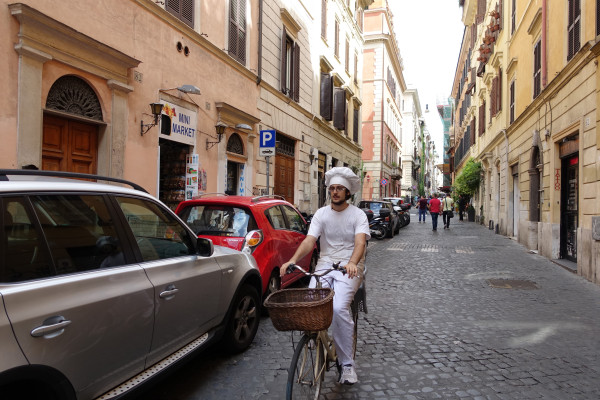 September means back to school for the students, and back to work for everyone else.
September means back to school for the students, and back to work for everyone else.
Restaurants and shops that closed in August are open again and people are refreshed, reinvigorated and in great moods. Service is never better.
September in Rome is a wonderful time for walks around the city. A really great walk is from Porta San Paolo along the ancient 2nd century Aurelian Wall to the Porta San Sebastiano. From San Sebastiano you can you through the gate and keep walking and you’ll end up at the Circus Maximus.
By the 3rd century, Rome had grown and outgrown the 6th century BC Servian wall fortification. Fearing invasions from the northern Germanic tribes, the Emperor Aurelian enlarged the city protection with a new 12mile long, 26’ tall brick faced concrete wall.
The walls were doubled in height to 52’ tall in the 4th century but it didn’t help. They were breached in 410 by Alaric and the Visigoths. They were breached again in 546 by Totila and the Ostrogoths, again in 1527 by the troops of the Holy Roman emperor Charles V and in 1870, when the forces of the Italian Re-unification broke through the wall near the Porta Pia, the wall defense of the city was no longer a top priority .
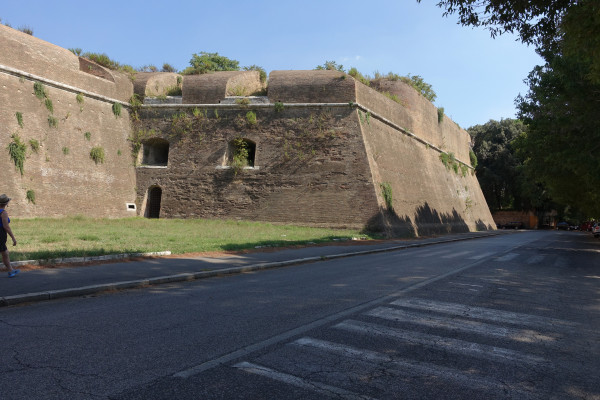 After the brutal Sack of Rome in 1527, Pope Paul III (Farnese) called on architect, Antonio da Sangallo the Younger to fortify the walls.
After the brutal Sack of Rome in 1527, Pope Paul III (Farnese) called on architect, Antonio da Sangallo the Younger to fortify the walls.
Although a few of the Sangallo Bastions did get built (mostly around the Vatican, of course), the project was too costly and never finished.
The best stretch of the 16th century massive Sangallo Bastions is between the Porta San Paolo and Porta San Sebastiano. They are impressive and unlike any other wall fortifications in Italy.
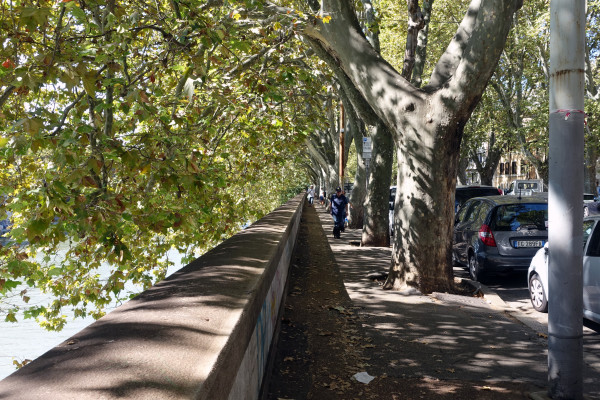 Another wonderful walk is by the river, along the Lungotevere. The leaves of the Plane Trees along the Tiber River are starting to fall across the river and the Lungotevere streets. These trees are not native to Rome. They were planted here by Napoleon in the early 19th century. Rome is mostly a city of pine trees, cypress and umbrella pines.
Another wonderful walk is by the river, along the Lungotevere. The leaves of the Plane Trees along the Tiber River are starting to fall across the river and the Lungotevere streets. These trees are not native to Rome. They were planted here by Napoleon in the early 19th century. Rome is mostly a city of pine trees, cypress and umbrella pines.
September Holidays are for everyone.
The big Catholic Festival for San Gennaro is further south in Naples but there are other commemorations of note in Rome.
For the Jewish community and the newly gentrified Jewish Ghetto September welcomes the Jewish New Year and the Holiest Day of Atonement.
There are less than 13,000 Jews living in Rome these days, a fraction of the original population that has been here since the 2nd century BC.
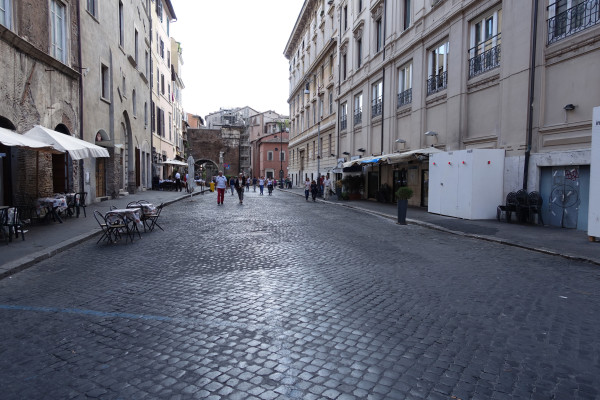 Roman Jewish cooking is world famous, mostly for carciofi alla giudia (deep fried baby artichokes).
Roman Jewish cooking is world famous, mostly for carciofi alla giudia (deep fried baby artichokes).
On the holiest day of the year (2015), the Jewish Ghetto was deserted. All shops were closed. All, except Nonna Betta, the restaurant made popular in 2011 by chef and food adventurer, Anthony Bourdain. His photo and review are enshrined in the front of the restaurant. Nonna Betta decided to take advantage of the lack of competition and while every other Jewish business in Rome was closed out of respect and observance of the holiday, Nonna Betta saw it as an opportunity to make a financial killing. Maybe Nonna Betta is a Jewish restaurant in name only but not really owned by Jewish people.

For Italian patriotism, the 20th of September marks the anniversary of the Italian Unification in 1870 when Pope Pius IX surrendered the city of Rome to King Vittorio Emanuele II.
The walls at Porta Pia were defended by barely 13,000 soldiers against the fast moving, sharp shooting, feather capped Bersagliere Infantry, the Pride of Piedmonte. Together with the rest of the Italian Unification Army, they amassed over 50,000.
The fight at this point was merely symbolic. Pope Pius IX (Mastatai-Ferretti) wanted a show of resistance just to establish the historical point that the city was not handed over to the new government. It took 3 hours of canon fire on September 20th, 1870 to break through the wall. 49 soldiers of the Italian Unification Army were killed and 19 Papal guards.
Porta Pia houses the Bersagliere museum that tells the story of the conquest, the heroes and the fallen. There is also a scale model of the famous battle.
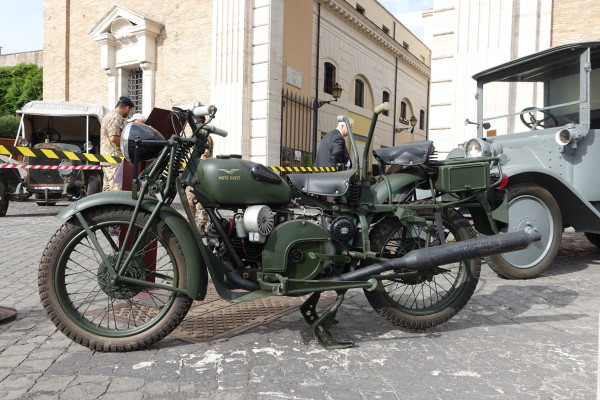 In the 2015 anniversary of the Italian Unification, the museum showcased some of the World War II vehicles used by Bersagliere soldiers. Yes, they are still around. For motorcycle enthusiasts, these are some really early Moto Guzzi.
In the 2015 anniversary of the Italian Unification, the museum showcased some of the World War II vehicles used by Bersagliere soldiers. Yes, they are still around. For motorcycle enthusiasts, these are some really early Moto Guzzi.
Every year on September 20th the Bersagliere don their famous grouse feathered hats and play marching band music around the city.
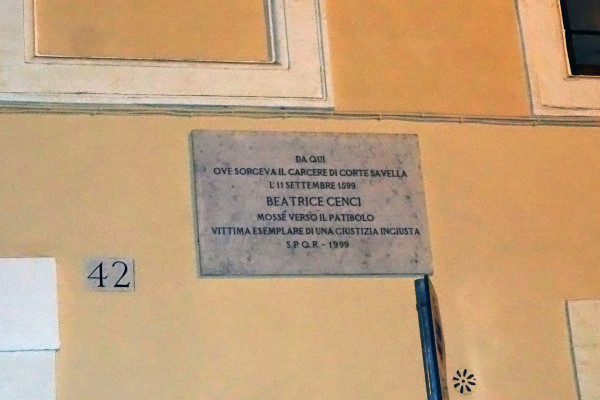 If you’re into ghost stories, September 11th is one of the best hauntings in the city. It the anniversary of the death of Beatrice Cenci on September 11, 1599. She and her mother and two brothers was found guilty in the death of her horribly abusive father. In reality, it was a crime of self defense but nonetheless, she was tortured in the Castel Sant’Angelo and killed on the scaffold build at the entrance to the Pont Sant’Angelo bridge.
If you’re into ghost stories, September 11th is one of the best hauntings in the city. It the anniversary of the death of Beatrice Cenci on September 11, 1599. She and her mother and two brothers was found guilty in the death of her horribly abusive father. In reality, it was a crime of self defense but nonetheless, she was tortured in the Castel Sant’Angelo and killed on the scaffold build at the entrance to the Pont Sant’Angelo bridge.
Every year on this night she haunts the streets from the location of the Corte Savella Prison on via di Monserrato to the Ponte Sant’Angelo bridge.
September is also a great time to visit the ancient monuments. The crowds are smaller, the air is clear and the light is crisp. In 2015, the monuments are the best they’ve looked since the 6th century.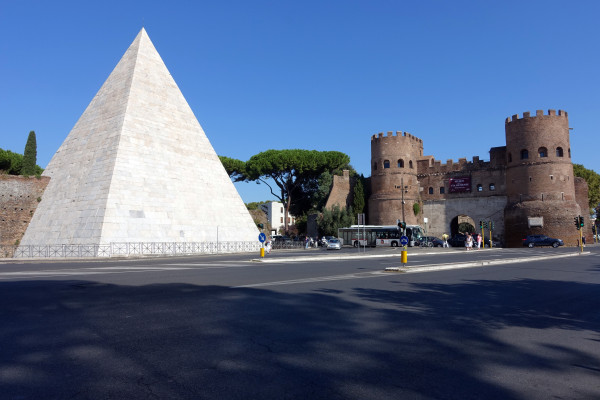
The 119’ tall Pyramid of Cestius was restored by the Yagi Tsusho LTD clothing company (Montcler, Barbour, Mackintosh, Kenzo, Woolrich, and more).
Gaius Cestius was the Imperial Banquet Manager/Party Planner to the Emperor Augustus. With his fortune he built himself a Pyramid Tomb, a tomb for one.
The Cestii were a very prominent family during this time. The Pons Cestius, the bridge that travels from the Tiburtina Island to Trastevere was named after another member of the family, but nonetheless, Gaius Cestius turned his back on his family when he sealed himself inside of his Pyramid.
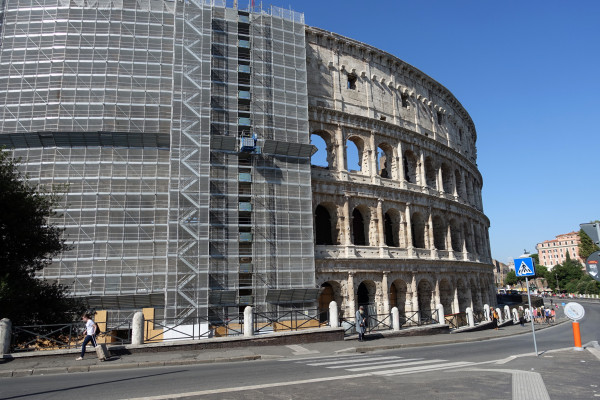 The Coliseum is in the final stages of its restoration, paid for by Diego Della Valle (Tod’s, Hogan).
The Coliseum is in the final stages of its restoration, paid for by Diego Della Valle (Tod’s, Hogan).
The Amphitheater interior is also getting a facelift. The floor over 1/3 of the arena has added a replica of one of the lifts that once brought wild animals into the arena. Yes, the lift does work.
The lower (hypogeum) belly under the arena floor has been cleaned up, arches repaired and there are currently plans to reconnect the lower level to the Ludus Magnus, the Gladiator arena that sits about 300’ away.
The Imperial Fori have been cleaned of weeds and garbage and straightened up into some kind of classical reorganization. It almost appears as if the archeologists are getting everything ready to put them back together. Personally, I think in the next year there’ll be information panels showing artistic recreations of what they looked like in classical times, an insight in how the visitor can reimagine them back together.
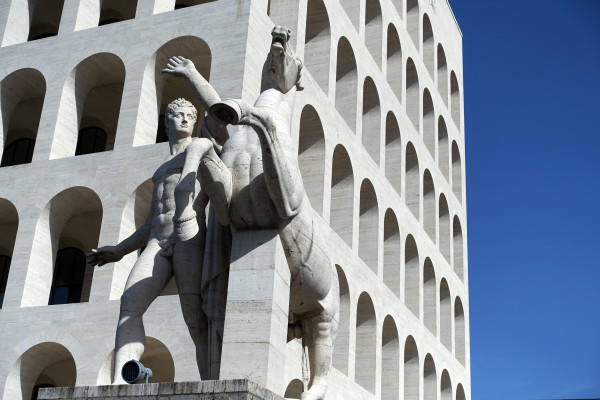 The Fendi sponsored restoration of the Trevi fountain is close being finished. Fendi is moving their International HQ to the Colosseo Quadrato in EUR. This was one of the show pieces of Mussolini’s failed 1942 World’s Fair. The Fendi House is cleaning up the great marble building and will take up residence at the end of 2015.
The Fendi sponsored restoration of the Trevi fountain is close being finished. Fendi is moving their International HQ to the Colosseo Quadrato in EUR. This was one of the show pieces of Mussolini’s failed 1942 World’s Fair. The Fendi House is cleaning up the great marble building and will take up residence at the end of 2015.
Rome has been a living museum for most of its existence, but it has just been in the past 4-5 years that the museum has updated the permanent exhibits. Every year there is something else uncovered or something else restored or something else to see. It definitely makes Rome the city to come back to.
The nights of September offer a lot to the Romans and the visitors.
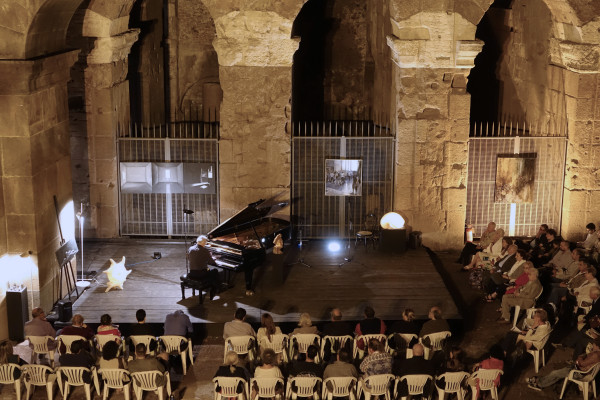 There are annual music concerts in the Teatro Marcello, the great theater built by Augustus to commemorate his nephew (of his sister, Octavia) and son-in-law (married to his daughter, Julia) who died of a mysterious death in Baiae in Campania at the age of 19. It currently is a mix of an ancient Roman theater and fortress because it was, in fact, turned into a fortress by the Fabii Family in the 11th century although the current look comes from Baldassare Peruzzi who built the urban Palazzo we see today for the Orsini family.
There are annual music concerts in the Teatro Marcello, the great theater built by Augustus to commemorate his nephew (of his sister, Octavia) and son-in-law (married to his daughter, Julia) who died of a mysterious death in Baiae in Campania at the age of 19. It currently is a mix of an ancient Roman theater and fortress because it was, in fact, turned into a fortress by the Fabii Family in the 11th century although the current look comes from Baldassare Peruzzi who built the urban Palazzo we see today for the Orsini family.
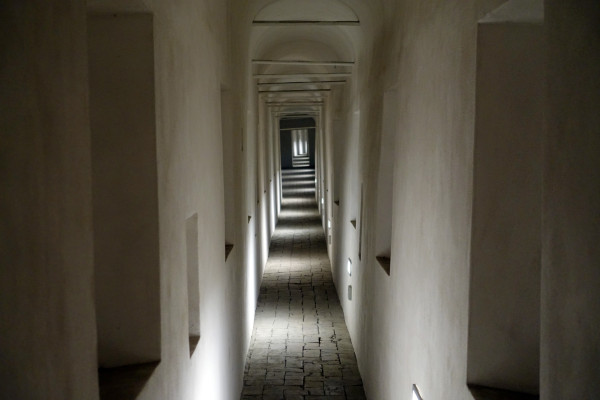
September brings concerts and night visits to the Castel Sant’Angelo including access to the treasury room, the famous 16th century bathroom of Pope Clement VIII (with hot and cold running water) and the apartments and cells of famous prisoners. The famous Passetto di Borgo was also open. This is basically the Papal escape passage from the Vatican to the Castel Sant’Angelo Fortress. The last time it was used for such an escape was in 1527 by Pope Clement VII.
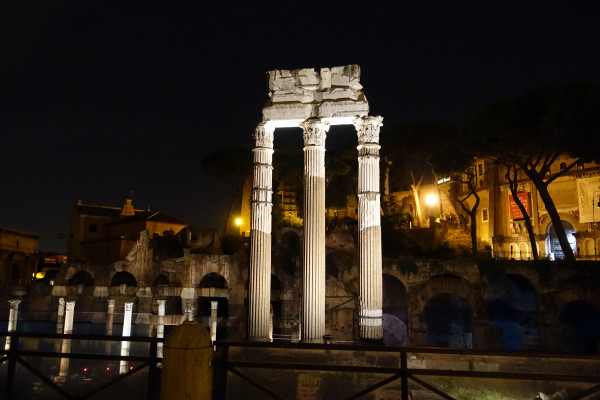 Sound and light shows are very popular throughout the summer months and through the end of October. The 2000th anniversary of the death of Augustus in 2014 brought a sound and video mapping show to the Forum of Augustus. It was so popular it came back again in 2015. Another show about the Forum of Julius Caesar started in 2015.
Sound and light shows are very popular throughout the summer months and through the end of October. The 2000th anniversary of the death of Augustus in 2014 brought a sound and video mapping show to the Forum of Augustus. It was so popular it came back again in 2015. Another show about the Forum of Julius Caesar started in 2015.
Groups of around 20 people are fitted with headsets and led through the ancient stones as stories and images are projected onto the columns and temples. You can find more information on this website.
The idea is the brainchild of Piero Angela, science writer, jazz pianist, television host and the mastermind of the Domus Romanae under the Palazzo Valentini where he rebuilt a 1st century Roman villa using video projection mapping.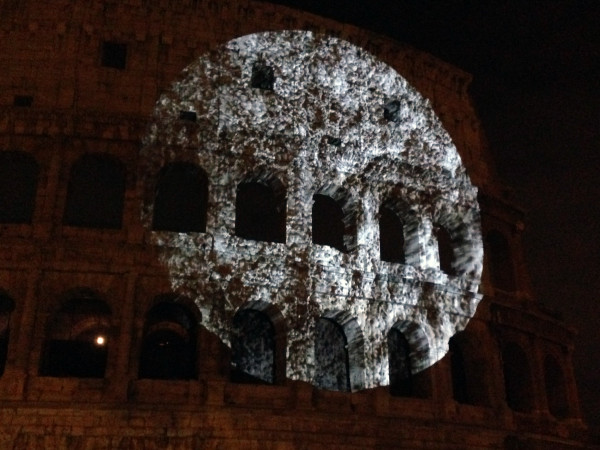
This year there was also a one night presentation of video imaging for an explanation of how the Coliseum was cleaned. It has been a 2 year project of pressured water, PH balanced water and gentil scrubbing. Petri dish fungus from the 1st century was captured and reimagined on the face of the newly cleaned surface.
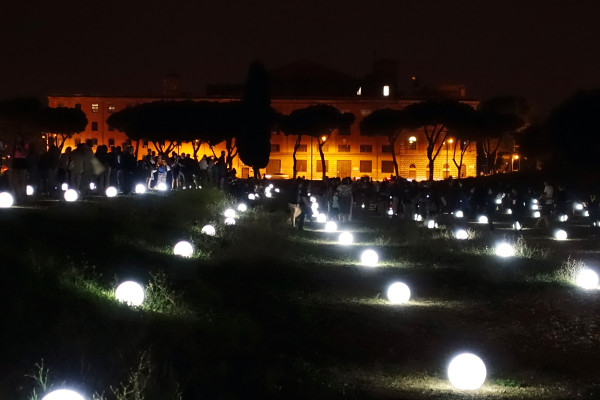 Outdoor art shows are also popular in September. This year a company filled the Circus Maximus with illuminated balls programmed to a dance beat music track. There were hundred of balls and the pulsating lights made the ancient racetrack seem like a giant dance club.
Outdoor art shows are also popular in September. This year a company filled the Circus Maximus with illuminated balls programmed to a dance beat music track. There were hundred of balls and the pulsating lights made the ancient racetrack seem like a giant dance club.
Lastly, September offers the end of the season of Shakespeare in the Park (Borghese park that is).
Rome’s Shakespeare theater is a scale replica of the Globe Theater based on the designs of the Globe replication built in London. The Roman Globe was built in 2003, financed by the Silvano Toti, a great Roman patron of the arts. It’s an open roofed theater built of oak with a capacity of 1200 people. Most shows are in Italian but this year there was a presentation of the Comedy of Errors in English.
September is a wonderful month to be in Rome. We can’t wait till next September to return…
If you’d like to see other photos from our 2015 September visit to Rome, click here.
You must be logged in to post a comment.